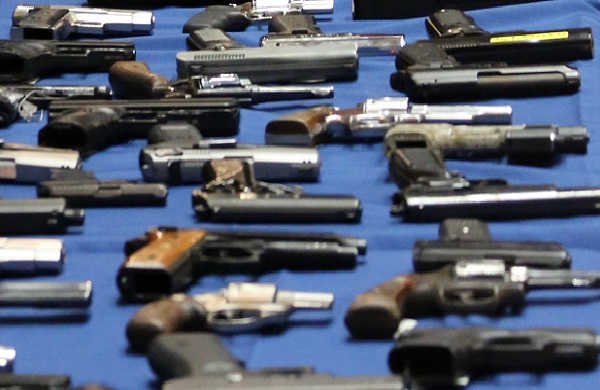
Photo by: City Hall
Guns displayed at an NYPD press conference. New York City has some of the toughest gun restrictions in the country, but they are undermined by lax regulations in other states.
Mass shootings are happening more often in the United States according to a recently released Federal Bureau of Investigation study. However, there are no serious attempts by decision-makers to restrict access to guns. Despite passage of the NY SAFE Act, gun violence is still a significant threat to public safety in New York because of easy access to firearms, many trafficked here from states with much weaker gun laws.
The FBI found 160 shootings between 2000 and 2013 that fit its definition of “active-shooter” events: “an individual actively engaged in killing or attempting to kill people in a populated area.”
On average there were 16.4 active-shooter incidents a year between 2006 and 2013; that increased from an average of 6.4 a year from 2000 to 2006. In all 486 people were killed and 557 wounded. Two thirds of incidents ended before police arrived. The study didn’t include gang-related violence, drug-related killings or individuals whose primary purpose was to commit suicide publicly.
While mass shootings are sometimes thought of as a suburban or rural phenomenon, they have occurred in New York. In 1997, a gunman opened fire on the observation deck of the Empire State Building, killing one person and wounding six others. The FBI report considers two incidents in the city—a 2007 shooting at the Co-op City leasing office that killed one and wounded two, and a 2011 shooting at a house party in South Jamaica that wounded 11. The threat is sufficiently present that the NYPD last year updated its protocol for dealing with active shooters.
The FBI report discussed the benefits of workplace training and teachers conducting drills on how to shelter or flee during an emergency. However mention of gun control didn’t make it into the report—although that is how one country responded to its most infamous mass shooting.
On April 28, 1996, 28-year-old Martin Bryant went on a killing spree that claimed 35 men, women and children in Port Arthur, Australia. At an historic prison colony turned tourist destination, Bryant entered a restaurant, removed an automatic rifle from his bag; and began shooting. After quickly killing 22 people, Bryant left the restaurant for the parking lot, where he continued his mass shooting, killing the drivers of two tour buses, some of their passengers and a mother and her two small children, among others.
On his way out of the parking lot, he murdered four people in a BMW and drove their car to a nearby gas station, where he shot one woman and took a man hostage who he later killed. He made it to a guesthouse, where after an 18-hour stand-off with police, Bryant set the guesthouse on fire, ran outside and was captured. Bryant was sentenced to life in prison, never to be released.
People across Australia were horrified by Bryant’s actions. In the hope of preventing similar crimes, gun-control laws in Australia were significantly strengthened in the aftermath of the tragedy.
Australian Governments and the Australasian Police Ministers’ Council struck while the “iron was hot.” When public sentiment was strong they met less than two weeks following the massacre to consider a proposal for a national gun control strategy.
At the meeting representatives agreed to a Nationwide Firearms Agreement. It included agreement on banning self-loading rifles, and self-loading and pump-action shotguns; and a 12-month firearms amnesty and compensation scheme (the gun “buy-back” scheme).
The gun buy-back scheme was a key element of the agreement. It meant each state and territory establishing and operating a system through which gun owners and dealers could surrender newly-prohibited weapons in return for compensation. Mechanisms were also built to compensate firearm dealers for loss of business relating to prohibited firearms.
The federal government funded both the administration of the scheme and the compensation payments made in relation to prohibited weapons. Meanwhile, a national public education campaign was undertaken in support of the buy-back scheme.
The operation started in most States on October 1 1996 and ended a year later. It netted the surrender of approximately 640,000 prohibited firearms nationwide. It was a government funded scheme through a one-time 0.2 percent increase in the Medicare levy to raise about $500 million. The total cost of compensation to owners was about $304 million.
A 2011 study concluded that, at the time the laws were passed in 1996, “it would have been difficult to imagine more compelling future evidence of a beneficial effect.”
Philip Alpers, an adjunct associate professor at the Sydney University, found in 2013: ‘Australia’s public health effort to reduce the risk of gun violence led the world, after melting down a million guns, the risk of an Australian dying by gunshot fell by more than half”.
Further, while there had been 11 gun massacres in the decade preceding 1996, there has been no mass shootings in Australia since.
Any such agreement amongst decision makers is the U.S would need to include standard issued military long guns, as well as handguns (which are more commonly used to such drastic effect in cities such as New York).
There has been great work done by New Yorkers to create the NY SAFE Act. However for dramatic change in gun violence there must be a more effective passage of laws affecting other states. New York is likely to be the state to take the lead. The key message for New Yorkers who want to effect real change: Australian governments were successful because they acted in a quick and comprehensive manner immediately after a catastrophic mass shooting—when national public sentiment was strong.







